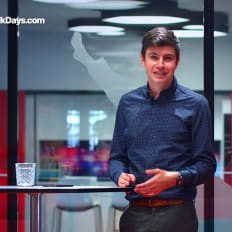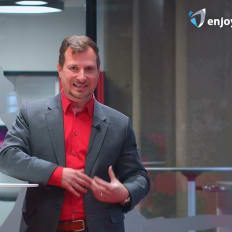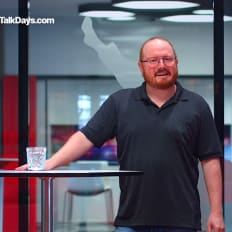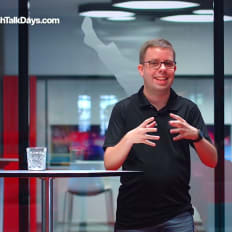
enjoy IT GmbH
Christof Amtmann, Project Manager bei enjoy IT
Description
Christof Amtmann von enjoy IT spricht im Interview darüber, wie er über Umwege zum Project Management gekommen ist, was seine aktuelle Arbeit umfasst und gibt Tipps für Neueinsteiger.
By playing the video, you agree to data transfer to YouTube and acknowledge the privacy policy.
Video Summary
In “Christof Amtmann, Project Manager bei enjoy IT,” Christof Amtmann explains his path into IT project management: starting in testing, moving to requirements engineering, stepping in when the project lead left, and later adding a PM certification and a part‑time Business Management degree. He portrays project management at enjoy IT as varied and project‑specific, built on planning, risk management, and tailored communication with developers, testers, sponsors, and executives while continually balancing quality, time, and budget. His takeaway: in Austria there’s rarely a direct study path—people grow into the role from technical or business backgrounds and learn to bridge both worlds.
From Tester to Project Lead: Christof Amtmann (enjoy IT GmbH) on Variety, Risk, and the Real Work of IT Project Management
Introduction: What we learned from “Christof Amtmann, Project Manager bei enjoy IT”
At DevJobs.at, we tuned into the session “Christof Amtmann, Project Manager bei enjoy IT” and found a refreshingly grounded account of project management in the real world. The speaker, Christof Amtmann from enjoy IT GmbH, walks through a path that starts—by his own words—“like most project managers, by detours,” and moves from testing to requirements engineering to an unplanned yet decisive leap into project leadership. His story is marked by variety, accountability, and continuous learning.
What stands out most: project management, in his world, isn’t a linear plan but a conscious choice once you realize you enjoy steering, communicating, and handling risks. It’s the transition from specialist to generalist, built on a stable foundation, a clear toolbox, and a fine sense for people.
The entry point: into leadership, by stepping up
Christof sketches his path without embellishment:
“I started in IT as a tester. For about a year and a half I tested software, read log files… then I switched into requirements engineering, describing requirements.”
The tipping point came when the project lead left. Because he was already well-connected in the project, knew the landscape, and had served in multiple roles, he took the initiative:
“I tried—well, I’ll take on the project management as well. And that’s how I got into project management.”
This moment—stepping up instead of hesitating—sets the tone. It wasn’t an accident; it was a decision to take responsibility. He stayed in the role and underpinned it with a project management certification and a part-time degree in business management. Both reinforce what he practices daily: solid craft, clear methods, and a grasp of numbers and organizational logic.
Variety as the default
Ask Christof for the first word that describes his job and he answers immediately:
“The first word that comes to mind is ‘varied’ [vielfältig].”
He places this variety squarely in IT project management. Even if the category looks similar—“maybe it’s a website or an SAP migration”—every project is different. Different stakeholders, different preconditions, different clients. As an editorial team, we take that as a reality check: the label “IT project” says little about the actual challenge. The difference emerges from people, context, and expectations.
This perspective punctures the hope for one-size-fits-all best practices. Instead, Christof moves the foundation into focus: “basic knowledge, basic structure, basic tools.” Planning, risk management, and communication form the frame that each project fills with its own specifics.
The foundation: planning, risk, communication
Christof describes his craft with crisp clarity:
- Planning—as structure, rhythm, and orientation for everyone involved.
- Risk management—to spot uncertainties early, weigh them, and act.
- Communication—tailored, respectful, precise; across developers, testers, project sponsors, and managing directors.
It’s not only about content but also tone and timing. Project leads must master a “balancing act”: what do different groups need to feel heard and still contribute to delivery? If you’ve ever tried to write one status update that works both for an engineer and a managing director, you know how much craft and empathy that requires.
The project triangle: quality, time, budget
Christof points to a hard truth about projects:
“A project has three core elements… quality, time, and budget. And one of those often doesn’t quite work out.”
This is not cynicism but pragmatism. Projects rarely run under ideal conditions. What matters is how you work with this triangle:
- Which objectives are non-negotiable, which are flexible?
- Where do you need active prioritization, instead of silent hope?
- How do you make visible what one decision (e.g., more features) does to the other legs of the triangle?
He connects this with two concrete leadership demands: working the budget and steering with consequence. Understand the numbers—and act accordingly. And: motivate, delegate, but also call things out when they’re off track. The project management he describes is equal parts enablement and accountability.
Many voices, one project: from engineers to executives
His communication spans “developers, testers, project sponsors, and managing directors.” The same project therefore requires different languages:
- Technical depth where decisions depend on understanding.
- Clarity and structure where scope, budget, and risks are at stake.
- Translation between the two so no team drifts out of sync.
This image is central to his story: project management operates at intersections. The work lies in shaping one shared picture out of diverse perspectives—without ignoring the friction that naturally arises.
Learning as a marathon: certification and business management
After his move into the role—“and then I basically stayed in project management until today”—Christof adds two purposeful steps: a PM certification and a part-time degree in business management. The subtext is clear: project management demands practice, but practice scales better when rooted in structured learning. And for IT projects, understanding the business side is part of the job: numbers, budgets, commercial logic.
We take this as a strong nudge for technical folks eyeing project management: you’ll go further if you lean into management and business. And conversely—as he notes—profiles with a business foundation can grow into IT by learning the basics and mechanics of the technical side.
No straight academic path: switching in as the norm
Christof is explicit about the career path:
“As far as I know, there’s basically no degree program in Austria that’s project management per se. You don’t start out as a project manager.”
In his view, project management is almost always a “second step” from another area—testing, development, architecture, or business. The shift is voluntary: you choose it because you enjoy steering, communicating, and handling risks and escalations. That demystifies simplistic path planning like “decide at 18, become a project manager by 20”—“very untypical,” he says. Instead, you grow into the role, recognize your strengths, and step up when the moment arrives (as it did for him when the project lead left).
From specialist to generalist: “a bit of everything”
One line from Christof nails the role:
“One of the tasks of the project manager is to know a bit of everything and roughly understand what people are talking about.”
This doesn’t mean project leads must be deep experts everywhere. But they need a robust baseline—across technology, testing, business, and governance. Add to that the “basic structure” and “project management tools” you “learn over time.” The message: depth sits with the experts; breadth belongs to the project lead. Between them lies translation, prioritization, and decision-making.
Two entry doors, one goal: tech learns business—business learns tech
Christof treats both starting points fairly: tech folks need to lean into management and business; business profiles need to learn enough IT to operate effectively. The target is the same: a project manager who can “cover all aspects somehow.” That “somehow” matters. It signals that the aim isn’t perfection in every discipline but credible working knowledge across domains—complemented by the team’s expertise.
For us, this is an argument for humility and the will to learn. You don’t need to know everything, but you need to know enough to ask good questions, recognize risks, steer decisions, and respect the people closest to the details.
Leadership in practice: motivate, delegate, address
Christof pinpoints three leadership moves that make the day-to-day difference:
- Motivate: make intent, goals, and progress visible—so the team keeps its energy.
- Delegate: hand over responsibility with clarity and trust.
- Address: if “it’s not going the way it should,” speak plainly—fairly, but firmly.
These aren’t buzzwords. They mark the work on Day X: in backlog refinement, in status reviews, in stakeholder exchanges, in budget talks. The quality of leadership shows where decisions actually hurt—for instance, when the project triangle needs to be rebalanced. Christof’s reminder that “one of the three often won’t quite work out” calls for precisely that kind of leadership.
Practical takeaways for developers and testers
If you come from the technical side and are considering project management, Christof’s path is encouraging. What can you draw from his account?
- Seek out interface roles: take on responsibility in requirements engineering, test coordination, or stakeholder-facing workstreams.
- Build the foundation: practice project planning, risk management, and status communication—intentionally and iteratively.
- Learn the language of numbers: budget logic, effort estimates, cost/benefit-driven prioritization—you don’t need to be a controller, but you should grasp the relationships.
- Practice tailored communication: what do engineers need to hear, what does management need to decide? Convey the same truth in different ways.
- Take your moment: when the chance arises to lead a work package or a small project, don’t reflexively say no. Christof’s path began with such a moment.
All of this tracks with the spirit of his statements without overstretching them: project management is a craft you build by taking responsibility, maintaining structure, and treating every perspective in the project with respect.
Self-check: am I ready for the move?
Christof’s description invites a candid self-assessment:
- Am I comfortable shaping complex content for different audiences?
- Does responsibility—including budget, risk, and escalation—motivate me?
- Am I ready to trade depth for breadth and “know a bit of everything”?
- Do I want to build a clear set of project management tools and apply them consistently?
- Can I carry decisions when quality, time, and budget can’t all be maximized at once?
If you find yourself answering “yes,” his story likely resonates with your next steps.
The reality of projects: when the ideal isn’t feasible
One notion from Christof’s account lingers: the acceptance that the project triangle rarely allows all three goals to be maximized simultaneously. This sobriety isn’t a deficit; it’s a sign of good practice. It protects the team from overextension, the sponsor from overpromising, and leadership from mismatched expectations. And it forces prioritization—arguably the core task of any project lead.
That dovetails with his emphasis on risk management. Name risks early, and you can create options. Ignore them, and they come back later as facts.
What enjoy IT enables for him: breadth and a clear role
Without adding details beyond the session, one thing is clear: Christof experiences his role at enjoy IT GmbH as broad and lively. “Especially at EnjoyIT I really have many different topics there.” That mirrors his definition of project management—where variety is the default and craftsmanship makes the difference.
For talent, we see a strong signal: if you seek variety, project management is not an accident-prone corner case but a field where variety is built-in—provided you’re willing to maintain the foundation.
Learning over time: not a school profession, but a learning profession
Christof emphasizes that project management is “not necessarily a vocational or academic profession.” The path is through experience, reflective practice, and a deliberate expansion of your toolbox. Certifications and degrees can flank that learning—but they don’t replace it. If you want to grow, you grow in the project.
That’s an invitation to pragmatic professionalism: choose tools, apply them, improve them. Talk to people. Treat risks systematically. Understand budgets. And keep listening.
Closing: the conscious step into project management
Christof Amtmann shows how opportunity can turn into responsibility—and how responsibility can become a sustainable role. If his account sounds familiar, your next step might be to engage more at the interfaces, sharpen your toolbox, and make the deliberate shift from specialist to generalist.
His message is clear and practical: rely on your basic knowledge, your basic structure, your basic tools. Then variety won’t dissolve into chaos—but into exactly what good IT projects are made of.
More Dev Stories

enjoy IT GmbH Julian Deleja-Hotko, Software Developer bei enjoy IT
Julian Deleja-Hotko von enjoy IT redet im Interview über seine Anfänge mit dem Programmieren, was er in seiner aktuellen Arbeit macht und was seiner Meinung nach für Neueinsteiger wichtig ist.
Watch now
enjoy IT GmbH Stefan Weinzettel, Bid Manager bei enjoy IT
Stefan Weinzettel von enjoy IT berichtet im Interview über seinen Weg in das Bid Management, wie er in seiner Rolle im Unternehmen mit Developern zusammenarbeitet und gibt Tipps für Einsteiger.
Watch now
enjoy IT GmbH Thomas Hochgatterer, Back End Developer bei enjoy IT
Thomas Hochgatterer von enjoy IT gibt im Interview Einblicke in seinen Werdegang mit dem Prorammieren, wie sich sein Arbeitsalltag als Back End Developer gestaltet und gibt Tipps für Neueinsteiger.
Watch now
enjoy IT GmbH Joachim Waldl, Front End Developer bei enjoy IT
Joachim Waldl von enjoy IT gibt im Interview einen Einblick in seinen Werdegang zum Programmieren, einen Überblick in seine aktuelle Arbeit im Front End Development und schließlich Tipps für Beginner.
Watch now
enjoy IT GmbH Oktay Akgül, Lead Developer bei enjoy IT
Oktay Akgül von enjoy IT erzählt im Interview wie er zum Programmieren gekommen ist, wie sich dann der Weg bis zu aktuellen Arbeit als Lead Developer gestaltet hat und gibt Tipps für Neueinsteiger.
Watch now
enjoy IT GmbH Thomas Hintersteiner, Software Architect bei enjoy IT
Thomas Hintersteiner von enjoy IT erzählt im Interview über seinen Weg – angefangen von der HTL bis hin zu seiner aktuellen Arbeit – und gibt Tipps für Personen die selbst mit dem Programmieren anfangen möchten.
Watch now






